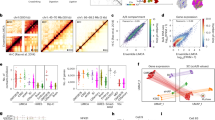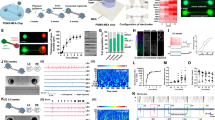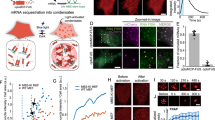Abstract
A heterogeneous population of inhibitory neurons controls the flow of information through a neural circuit1,2,3. Inhibitory synapses that form on pyramidal neuron dendrites modulate the summation of excitatory synaptic potentials4,5,6 and prevent the generation of dendritic calcium spikes7,8. Precisely timed somatic inhibition limits both the number of action potentials and the time window during which firing can occur8,9. The activity-dependent transcription factor NPAS4 regulates inhibitory synapse number and function in cell culture10, but how this transcription factor affects the inhibitory inputs that form on distinct domains of a neuron in vivo was unclear. Here we show that in the mouse hippocampus behaviourally driven expression of NPAS4 coordinatesthe redistribution of inhibitory synapses made onto a CA1 pyramidal neuron, simultaneously increasing inhibitory synapse number on the cell body while decreasing the number of inhibitory synapses on the apical dendrites. This rearrangement of inhibition is mediated in part by the NPAS4 target gene brain derived neurotrophic factor (Bdnf), which specifically regulates somatic, and not dendritic, inhibition. These findings indicate that sensory stimuli, by inducing NPAS4 and its target genes, differentially control spatial features of neuronal inhibition in a way that restricts the output of the neuron while creating a dendritic environment that is permissive for plasticity.
This is a preview of subscription content, access via your institution
Access options
Subscribe to this journal
Receive 51 print issues and online access
$199.00 per year
only $3.90 per issue
Buy this article
- Purchase on Springer Link
- Instant access to full article PDF
Prices may be subject to local taxes which are calculated during checkout




Similar content being viewed by others
References
Somogyi, P. & Klausberger, T. Defined types of cortical interneurone structure space and spike timing in the hippocampus. J. Physiol. (Lond.). 562, 9–26 (2005)
Danglot, L., Triller, A. & Marty, S. The development of hippocampal interneurons in rodents. Hippocampus 16, 1032–1060 (2006)
Freund, T. F. & Buzsáki G Interneurons of the hippocampus. Hippocampus 6, 347–470 (1996)
Turner, D. A. Feed-forward inhibitory potentials and excitatory interactions in guinea-pig hippocampal pyramidal cells. J. Physiol. (Lond.). 422, 333–350 (1990)
Liu, G. Local structural balance and functional interaction of excitatory and inhibitory synapses in hippocampal dendrites. Nature Neurosci. 7, 373–379 (2004)
Chiu, C. Q. et al. Compartmentalization of GABAergic inhibition by dendritic spines. Science 340, 759–762 (2013)
Larkum, M. E., Zhu, J. J. & Sakmann, B. A new cellular mechanism for coupling inputs arriving at different cortical layers. Nature 398, 338–341 (1999)
Miles, R., Toth, K., Gulyas, A. I., Hajos, N. & Freund, T. F. Differences between somatic and dendritic inhibition in the hippocampus. Neuron 16, 815–823 (1996)
Pouille, F. & Scanziani, M. Enforcement of temporal fidelity in pyramidal cells by somatic feed-forward inhibition. Science 293, 1159–1163 (2001)
Lin, Y. et al. Activity-dependent regulation of inhibitory synapse development by Npas4. Nature 455, 1198–1204 (2008)
Adesnik, H., Li, G., During, M. J., Pleasure, S. J. & Nicoll, R. A. NMDA receptors inhibit synapse unsilencing during brain development. Proc. Natl Acad. Sci. USA 105, 5597–5602 (2008)
Chen, J. L. et al. Clustered dynamics of inhibitory synapses and dendritic spines in the adult neocortex. Neuron 74, 361–373 (2012)
van Versendaal, D. et al. Elimination of inhibitory synapses is a major component of adult ocular dominance plasticity. Neuron 74, 374–383 (2012)
Kim, T. K. et al. Widespread transcription at neuronal activity-regulated enhancers. Nature 465, 182–187 (2010)
Rocamora, N., Welker, E., Pascual, M. & Soriano, E. Upregulation of BDNF mRNA expression in the barrel cortex of adult mice after sensory stimulation. J. Neurosci. 16, 4411–4419 (1996)
Castrén, E., Zafra, F., Thoenen, H. & Lindholm, D. Light regulates expression of brain-derived neurotrophic factor mRNA in rat visual cortex. Proc. Natl Acad. Sci. USA 89, 9444–9448 (1992)
Lein, E. S. & Shatz, C. J. Rapid regulation of brain-derived neurotrophic factor mRNA within eye-specific circuits during ocular dominance column formation. J. Neurosci. 20, 1470–1483 (2000)
Falkenberg, T. et al. Increased expression of brain-derived neurotrophic factor mRNA in rat hippocampus is associated with improved spatial memory and enriched environment. Neurosci. Lett. 138, 153–156 (1992)
Marty, S., Wehrle, R. & Sotelo, C. Neuronal activity and brain-derived neurotrophic factor regulate the density of inhibitory synapses in organotypic slice cultures of postnatal hippocampus. J. Neurosci. 20, 8087–8095 (2000)
Kohara, K. et al. A local reduction in cortical GABAergic synapses after a loss of endogenous brain-derived neurotrophic factor, as revealed by single-cell gene knock-out method. J. Neurosci. 27, 7234–7244 (2007)
Baldelli, P., Hernandez-Guijo, J.-M., Carabelli, V. & Carbone, E. Brain-derived neurotrophic factor enhances GABA release probability and nonuniform distribution of N- and P/Q-type channels on release sites of hippocampal inhibitory Synapses. J. Neurosci. 25, 3358–3368 (2005)
Pattabiraman, P. P. et al. Neuronal activity regulates the developmental expression and subcellular localization of cortical BDNF mRNA isoforms in vivo. Mol. Cell. Neurosci. 28, 556–570 (2005)
Brigadski, T., Hartmann, M. & Lessmann, V. Differential vesicular targeting and time course of synaptic secretion of the mammalian neurotrophins. J. Neurosci. 25, 7601–7614 (2005)
Dean, C. et al. Distinct subsets of Syt-IV/BDNF vesicles are sorted to axons versus dendrites and recruited to synapses by activity. J. Neurosci. 32, 5398–5413 (2012)
Atallah, B. V., Bruns, W., Carandini, M. & Scanziani, M. Parvalbumin-expressing interneurons linearly transform cortical responses to visual stimuli. Neuron 73, 159–170 (2012)
Lovett-Barron, M. et al. Regulation of neuronal input transformations by tunable dendritic inhibition. Nature Neurosci. 15, 423–430 (2012)
Royer, S. et al. Control of timing, rate and bursts of hippocampal place cells by dendritic and somatic inhibition. Nature Neurosci. 15, 769–775 (2012)
Lee, S. H. et al. Activation of specific interneurons improves V1 feature selectivity and visual perception. Nature 488, 379–383 (2012)
Ploski, J. E., Monsey, M. S., Nguyen, T., DiLeone, R. J. & Schafe, G. E. The neuronal PAS domain protein 4 (Npas4) is required for new and reactivated fear memories. PLoS ONE 6, e23760 (2011)
Ramamoorthi, K. et al. Npas4 regulates a transcriptional program in CA3 required for contextual memory formation. Science 334, 1669–1675 (2011)
Acknowledgements
We thank members of the Greenberg laboratory for comments, suggestions and critical reading of the manuscript. We thank A. Mardinly for observations and comments on NPAS4 protein induction, P. Greer and S. Flavell for observations and comments on Npas4 mRNA induction in response to enriched environment and B. Cruz Moreno for help with sectioning. We thank M. During for the gift of the AAV-Cre–GFP plasmid. GFP–gephyrin images were collected at the UCSD Neuroscience Microscopy Shared Facility sponsored by grant P30 NS047101. This work was funded by Helen Hay Whitney Foundation, L’Oreal USA Fellowship for Women in Science and The Medical Foundation/Charles A. King Trust Postdoctoral Fellowship (B.L.B.), NSF graduate student research fellowship (N.S.) and National Institutes of Health grant NS028829 (M.E.G.).
Author information
Authors and Affiliations
Contributions
Experiments were designed by B.L.B., N.S. and M.E.G. Experiments were conducted and analysed by B.L.B., N.S., H.A.B. and A.Z.T. The manuscript was written by B.L.B., N.S. and M.E.G.
Corresponding author
Ethics declarations
Competing interests
The authors declare no competing financial interests.
Extended data figures and tables
Extended Data Figure 1 Infection with AAV-Cre-GFP effectively excises Npas4.
a, Schematic of the AAV-Cre–GFP virus genome. b, Representative hippocampal section from an AAV-Cre–GFP; Npas4f/f animal 3 h after kainic acid injection. Sections were imaged for native GFP fluorescence (green) and immunostained NPAS4 (red) and NeuN (blue) protein. c, Quantification of neurons with overlapping GFP and NPAS4 in the sections represented in b. n = 14 neurons, *P < 0.01.
Extended Data Figure 2 NPAS4-dependent changes in inhibition require loss of NPAS4 in excitatory neurons.
a, mIPSCs frequency (left) and amplitude (right) were measured from pairs of neighbouring GFP+and GFP− neurons from wild-type (C57BL/6) mice maintained in standard housing. n = 17 pairs. b, mIPSCs frequency (left) and amplitude (right) were measured from pairs of neighbouring GFP+ and GFP− neurons from wild-type (C57BL/6) mice 24 h after injection of kainic acid. n = 17 pairs. Open circles indicate individual GFP+/GFP−pairs. Red circles indicate mean ± s.e.m. c, Representative hippocampal CA1 section from an EMX-Cre;Npas4f/+ and EMX-Cre;Npas4f/f mouse 3 h after kainic acid injection. Sections were immunostained for NPAS4 (red) protein. d, Quantification of NPAS4 immunoreactivity. n = 9 sections from 3 animals. *P < 0.05. e, mIPSCs frequency and amplitude measured from neurons in EMX-Cre;Npas4f/f mice maintained in standard housing (n = 14 neurons) or 24 h after kainic acid injection (n = 16 neurons). freq: P < 0.01; amp: P < 0.05.
Extended Data Figure 3 Stimulation of axons in different hippocampal layers generates eIPSCs with distinct rise times.
a, Cartoon of a CA1 pyramidal neuron and example eIPSCs generated in response to stimulation of axons in lacunosum (L, blue), radiatum (R, yellow), pyramidale (P, red) and oriens (O, green). Slopes (10–90% of the peak eIPSC) are indicated by coloured lines. b, Standard housing summary of the slopes of the eIPSC rise times recorded from neighbouring NPAS4-WT and NPAS4-KO neurons in response to stimulation of axons in each of the four hippocampal layers. Measurements are from eIPSCs in Fig. 2b–e. c, Enriched environment summary of the slopes as in b. Measurements are from eIPSCs in Fig. 2f–i. d, Kainic acid summary of the slopes as in (b). Measurements are from eIPSCs in Extended Data Fig. 4b–e.
Extended Data Figure 4 NPAS4 differentially regulates inhibitory synapses across the somato-dendritic axis of pyramidal neurons in response to kainic acid.
a, Experimental configuration. L, lacunosum; R, radiatum; P, pyramidale; O, oriens. b–e, eIPSCs measured from mice injected with kainic acid. Top shows average eIPSC, normalized pairwise to the wild-type neuron, measured from NPAS4-WT (black) and NPAS4-KO (green) neurons in response to stimulation in lacunosum (b), radiatum (c), pyramidale (d) or oriens (e). Scale bars indicate per cent change from wild type. Bottom shows eIPSC amplitude measured from pairs of neighbouring NPAS4-KO and NPAS4-WT neurons in response to stimulation of axons in lacunosum (b) (n = 13 pairs); radiatum (c) (n = 17 pairs, P < 0.05); pyramidale (d) (n = 18 pairs, P < 0.01); or oriens (e) (n = 15 pairs, P < 0.05). Open circles represent NPAS4-KO/NPAS4-WT pairs. Red circles indicate mean ± s.e.m.
Extended Data Figure 5 Sholl analysis and paired pulse ratios for NPAS4-WT and NPAS4-KO neurons from mice injected with kainic acid.
a, Schematic of the AAV-YFP-2A-Cre virus genome used for Sholl analysis. b, Kainic acid example NPAS4-WT and NPAS4-KO CA1 pyramidal neurons (left) and quantification of NPAS4-WT (black, n = 10 neurons) and NPAS4-KO (red, n = 13 neurons) dendrites (right). c–e, PPRs measured from NPAS4-WT and NPAS4-KO neurons in response to stimulation in radiatum (c), pyramidale (d) or oriens (e). Standard housing (black) or kainic acid (red). Standard housing data are re-plotted from Fig. 3c–e. R, n = 11 neurons; P, n = 13 neurons; O, n = 8 neurons. All data are shown as mean ± s.e.m.
Extended Data Figure 6 Functional screen of putative NPAS4 target genes identifies many genes that regulate mIPSCs frequency or amplitude.
a, b, mIPSCs were recorded from CA1 pyramidal neurons transfected with a pool of three shRNAs targeting a single putative NPAS4 target gene. mIPSC frequency (a) and amplitude (b) of those significantly different from control are shown. Knockdown of genes that result in fewer or smaller mIPSCs are shown on top (mustard); knockdown of genes that result in more or larger mIPSCs are shown on the bottom (blue). The dashed line represents the median value from control conditions. P < 0.05.
Extended Data Figure 7 Validation of five putative NPAS4 target genes.
a–e, Select putative NPAS4 target genes that influence mIPSC frequency and/or amplitude were subjected to additional validation: Npas4 (a), Bdnf (b), Pcsk1 (c), Penk1 (d) and Adycap1 (e). Top shows mIPSC frequency and amplitude recorded from CA1 pyramidal neurons that were transfected with individual shRNAs from the pool used in the primary screen. The mean ± s.e.m. mIPSC frequency and amplitude recorded from control neurons is indicated by the grey bar. Expression of individual shRNAs phenocopied expression of the pool. Bottom shows expression of target-specific shRNAs reduces expression of the target protein. f, qRT–PCR using primers specific to the target gene indicate that all five genes are induced in the hippocampus and their induction is misregulated in NPAS4 knockout neurons. Standard housing, n = 5 animals; kainic acid, n = 6 animals. All data are shown as mean ± s.e.m. *P < 0.05.
Extended Data Figure 8 Many putative NPAS4 target genes do not regulate inhibitory synapses.
a, b, mIPSCs were recorded from CA1 pyramidal neurons transfected with a pool of three shRNAs targeting a single putative NPAS4 target gene. mIPSC frequency (a) and amplitude (b) of those not significantly different from control are shown.
Extended Data Figure 9 BDNF regulates somatic inhibitory synapses in response to kainic acid.
a–c, eIPSCs were measured simultaneously from neighbouring BDNF4-WT (black) and BDNF-KO (green) neurons from mice injected with kainic acid. Top shows average eIPSC, normalized pairwise to the wild-type neuron, measured from BDNF-WT (black) and BDNF-KO (green) neurons in response to stimulation of axons in radiatum (a), pyramidale (b) or oriens (c). Scale bars indicate per cent change from wild type. Bottom shows eIPSC amplitude measured from pairs of neighbouring BDNF-KO and BDNF-WT neurons in response to stimulation of axons in radiatum (a) (n = 14 pairs), pyramidale (b) (n = 12 pairs, P < 0.01), or oriens (c) (n = 15 pairs). Open circles represent BDNF-KO/BDNF-WT pairs. Red circles indicate mean ± s.e.m.
Supplementary information
Supplementary Data
This file contains Supplementary Tables 1-4. (PDF 207 kb)
Rights and permissions
About this article
Cite this article
Bloodgood, B., Sharma, N., Browne, H. et al. The activity-dependent transcription factor NPAS4 regulates domain-specific inhibition. Nature 503, 121–125 (2013). https://doi.org/10.1038/nature12743
Received:
Accepted:
Published:
Issue Date:
DOI: https://doi.org/10.1038/nature12743
This article is cited by
-
Biphasic Npas4 expression promotes inhibitory plasticity and suppression of fear memory consolidation in mice
Molecular Psychiatry (2024)
-
Identifying foetal forebrain interneurons as a target for monogenic autism risk factors and the polygenic 16p11.2 microdeletion
BMC Neuroscience (2023)
-
Integrative transcriptome- and DNA methylation analysis of brain tissue from the temporal pole in suicide decedents and their controls
Molecular Psychiatry (2023)
-
A NPAS4–NuA4 complex couples synaptic activity to DNA repair
Nature (2023)
-
Activity-Dependent Differential Regulation of Auts2 Isoforms In Vitro and In Vivo
Molecular Neurobiology (2023)
Comments
By submitting a comment you agree to abide by our Terms and Community Guidelines. If you find something abusive or that does not comply with our terms or guidelines please flag it as inappropriate.



